One of the most important global meetings on wildlife trade has just wrapped up in Uzbekistan. It’s capital city Samarkand was where governments convened for the 20th Conference of the Parties (CoP20) to the Convention on International Trade in Endangered Species of Wild Fauna and Flora (CITES) to decide how international trade should be managed for some of the world’s most threatened...
Today, September 7th, is National Threatened Species Day. This day serves to raise awareness of native species that are under threat. With 20 new plant and wildlife species added to Australia’s threatened species list this week alone, this day is more important than ever.
Today we celebrate the members of Humane Society International’s private land conservation program, the Wildlife Land Trust (WLT), who each strive to support wildlife and habitat on their land. The conservation efforts of more than 930 landowners protect just over 88,000 hectares across Australia. From Carnaby’s black-cockatoos in the west, through to grey-headed flying-foxes along the east coast, mahogany gliders in the north, down to forty-spotted pardalotes at the foot of Tasmania, the presence of threatened species on WLT sanctuaries around the country highlights the important role private landholders can play to protect our native threatened wildlife.
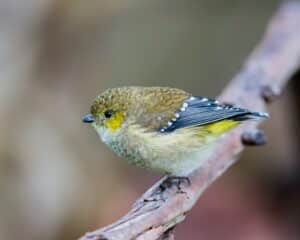 WLT sanctuary ‘Inala’ is the most significant site in the world for forty-spotted pardalotes. Image: Andrew Browne
WLT sanctuary ‘Inala’ is the most significant site in the world for forty-spotted pardalotes. Image: Andrew Browne
Not all WLT sanctuaries provide such a major contribution to threatened species protection individually, though when considered collectively they are seen to play a huge role in the bigger picture through habitat connectivity, providing recovery sites for species, and a strong presence in biodiversity hotspots.
Site Specifics
Saving our Species (SOS) is a conservation program run by the NSW Office of Environment and Heritage that aims to secure threatened species in the wild. Conservation projects are run at key management sites across the state to secure species with discrete populations.
Comparing the locations of Wildlife Land Trust sanctuaries in New South Wales with SOS sites, we found that around locations for the protection and recovery of threatened species such as the yellow-spotted tree frog, regent honeyeater, eastern chestnut mouse, Bathurst copper butterfly, and Minyon quandong.
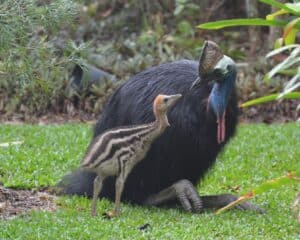 More than 50 WLT sanctuaries provide habitat for endangered cassowaries. Image: Rob Tidley
More than 50 WLT sanctuaries provide habitat for endangered cassowaries. Image: Rob Tidley
Many other threatened species with restricted ranges outside NSW, such as the southern cassowary, also benefit significantly from the efforts of Wildlife Land Trust members. Fifty-three WLT sanctuaries covering more than 1,480 hectares in the Wet Tropics of Queensland provide habitat for these endangered cassowaries.
As well as safeguarding habitat for her resident southern cassowaries through her WLT sanctuary WLT member Ingrid Marker’s significant advocacy work for the southern cassowary has created tangible legal changes. Ingrid is the founder and manager of the community group Guardians of the Wet Tropics. This group works alongside Traditional Owners, landholders and other groups to enhance habitats and conserve threatened species in the Wet Tropics, with a particular focus on conserving the southern cassowary.
Inspired by the cassowaries living on her property, Ingrid has been instrumental in having dogs recognised as a threatening process to cassowaries. Ingrid’s advocacy has also seen the establishment of harsher penalties for irresponsible dog ownership in the Queensland Animal Management Act. Additionally, Ingrid has recently established a restriction that allows private property owners in Queensland to designate their properties as dog and cat-free on State Title in-perpetuity. Her own property will be the first to be listed under this new protection, ensuring the preservation of native species for the future.
Connectivity
A significant threat to Australian wildlife is habitat loss, fragmentation, and degradation. Restoring ecosystem connectivity by maintaining and creating wildlife corridors is a way that wildlife routes can be re-established allowing species to move more freely.
Threatened species cannot be saved by the public reserve system alone, with even the largest protected areas essentially acting as ‘islands’ of habitat. Member owned sanctuaries of the WLT act as important refuges for native flora and fauna creating linkages and corridors between protected areas and other core habitats and increasing ecosystem connectivity.
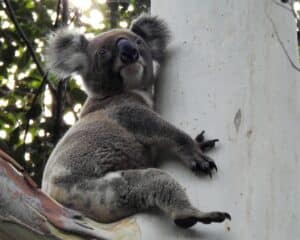 WLT member sanctuaries act as important refuges for native flora and fauna. Image: Ron and Sandra Clark
WLT member sanctuaries act as important refuges for native flora and fauna. Image: Ron and Sandra Clark
Biodiversity Hotspots
Biodiversity hotspots are the places on earth richest in biodiversity. Conservation International has identified 36 global biodiversity hotspots which, while representing just 2.5 per cent of the planet’s land surface, collectively support more than half of the world’s plant diversity and 43 per cent of bird, mammal, reptile, and amphibian species. The hotspots have all lost at least 70 per cent of their original habitat, and two are in Australia: the Forests of Eastern Australia; and Southwest Australia.
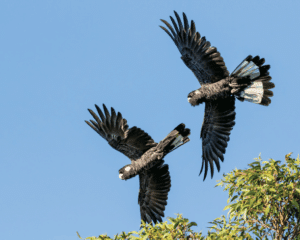 Ten Wildlife Land Trust sanctuaries in Western Australia have recorded the presence of the endangered Carnaby cockatoos, a species endemic to south-western Western Australia.
Ten Wildlife Land Trust sanctuaries in Western Australia have recorded the presence of the endangered Carnaby cockatoos, a species endemic to south-western Western Australia.
The Wildlife Land Trust has a great presence in these areas, Almost 3,000 hectares of the 47 current Western Australian WLT sanctuaries fall within the bounds of the Southwest Australia hotspot, contributing to the preservation of habitat for a plethora of threatened species. Among these are iconic animals such as the greater bilby, numbat, quokka, chuditch and woylie, as well as birdlife including malleefowl and forest red-tailed, Baudin’s, and Carnaby’s black cockatoos. WLT sanctuaries in Southwest Australia also provide habitat for the tiny nectar and pollen-feeding honey possum, which is the only member of its Family.
Threatened Species and WLT Wildlife Rehabilitators
The owners of more than 240 Wildlife Land Trust sanctuaries are actively involved in the care of orphaned or injured wildlife. While many of the species commonly cared for (such as eastern grey kangaroos, bare-nosed wombats and brush-tailed possums) are relatively abundant, WLT members also play a key conservation role through the rehabilitation and release of threatened wildlife. Among these species are Tasmanian devils, southern cassowaries, mahogany gliders, spectacled and grey-headed flying-foxes, and eastern quolls.
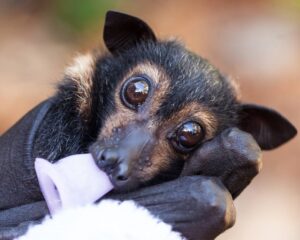 More than 240 Wildlife Land Trust sanctuaries are actively involved in the care of orphaned or injured wildlife, including spectacled flying foxes at Nightwings Rainforest Centre. Image: Annie Schoenberger
More than 240 Wildlife Land Trust sanctuaries are actively involved in the care of orphaned or injured wildlife, including spectacled flying foxes at Nightwings Rainforest Centre. Image: Annie Schoenberger
The sole purpose of dozens of WLT sanctuaries is to rehabilitate wildlife, including Tolga Bat Hospital, owned by Jenny Maclean which features world-class facilities and offers a volunteer program for the care of several bat and flying-fox species. Another is Annie Schoenberger’s Nightwings Rainforest Centre, a former sugar cane farm currently undergoing restoration to reinstate complex lowland rainforest. In addition to a dedicated bat and flying fox hospital, Nightwings runs an education centre which aims to increase awareness and respect for the often-misunderstood creatures.
Specialist bird rehabilitators such as Peggy McDonald of Holmesdale Farm also support the care of threatened avian species such as gang gang cockatoos.
With our already battered biodiversity under increasing pressure nationally, there is no doubt that the rapidly growing Wildlife Land Trust network will play an ever-more important role in protecting threatened wildlife and their habitats. Our members’ efforts continue to inspire us!
Do you own an acre or more of wildlife-friendly land? Learn more about the Wildlife Land Trust, Humane Society International Australia’s national private land conservation network or join the free and inclusive network today!


